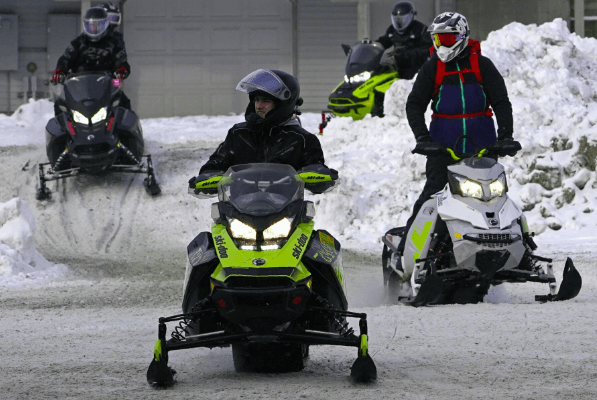
Best place to snowmobile in Canada
Snowmobiling in Canada is a captivating journey into a winter wonderland of vast, untouched landscapes and pristine snow-covered terrain. From the rough and lonely wilderness of the northern territories to the scenic routes of the eastern provinces, Canada provides a broad range of snowmobiling adventures for riders of all skill levels. This introduction serves as a doorway to some of Canada’s top snowmobile destinations, each with its own distinct character and terrain.
Whether you’re looking for the adrenaline rush of mountain adventures in British Columbia, huge trail networks in Quebec, or the coastline splendour of Newfoundland and Labrador, Canada’s snowmobile locations guarantee spectacular winter adventures. Join us as we explore the best snowmobile spots in this vast and snow-covered region.
Where is the best place to snowmobile in Canada?
1-Yukon Snowmobiling
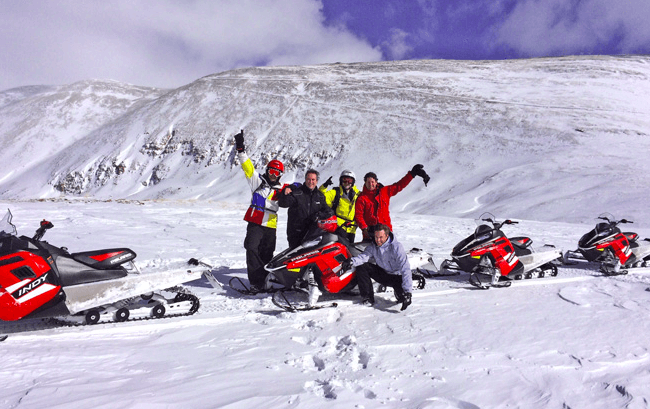
Snowmobiling in Yukon, Canada, provides an exciting and one-of-a-kind experience in the northern wilderness. Here’s a quick rundown of snowmobiling in Yukon:
Remote Wilderness:
Yukon is recognised for its vast, isolated wilderness, which allows snowmobilers to explore pristine areas that have been relatively unspoiled by industrialization. The rough topography of the area includes mountains, forests, and frozen lakes.
Long snowmobile Season:
Because of its northern position, Yukon’s snowmobile season may begin as early as November and last until April. This longer season is a big lure for snowmobilers who want to appreciate the splendour of winter for a long time.
Diverse Terrain:
Snowmobilers may enjoy a variety of terrain, from the alpine meadows of the St. Elias Mountains to deep boreal woods.
Yukon is excellent for riders of all ability levels, from novices to seasoned enthusiasts, because to its versatility.
A One-of-a-Kind Northern Experience:
Snowmobiling in Yukon allows you to experience the distinctive northern culture, see the Northern Lights, and explore distant, undisturbed nature.
Safety:
Given the frequently difficult and isolated nature of the terrain, safety is a key consideration for Yukon snowmobilers. Riders must be prepared for changeable weather conditions and carry necessary safety equipment.
Local Organisations and Services:
Yukon has snowmobile clubs and organisations that maintain routes, offer riders with useful information, and assist assure trail safety.
Yukon snowmobiling offers a great opportunity to see the unspoiled splendour of the northern wilderness and explore a place that has remained largely unaffected by commercialization. Yukon is a fantastic location for anyone looking for a tough and immersive snowmobiling journey in Canada’s far north, thanks to its lengthy snowmobile season and diversified terrain. This is one of the Best place to snowmobile in Canada.
2- Newfoundland and Labrador snowmobiling
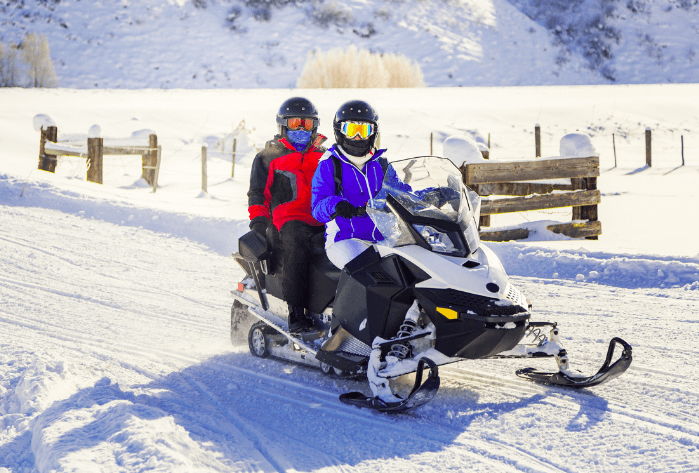
Snowmobiling in Newfoundland and Labrador is a one-of-a-kind and exciting experience in eastern Canada. The following is a synopsis of snowmobiling in Newfoundland and Labrador:
Coastal and Remote Terrain:
This province is recognised for its coastline and isolated nature, which offers snowmobilers a unique experience in comparison to other Canadian provinces. Riders may explore the island of Newfoundland’s harsh and scenic landscapes, as well as the huge Labrador wilderness.
Varied Trail System:
Snowmobile tracks in Newfoundland and Labrador range from coastal routes with ocean vistas to backcountry excursions through woods and harsh terrain. The Viking Trail on Newfoundland’s west coast is a popular route that offers a combination of seaside and interior riding.
Season:
Depending on local weather conditions, the snowmobile season normally lasts from December to April. Because of its northern position, the season in certain locations may begin earlier and stay longer.
One-of-a-Kind Culture:
Snowmobiling in this region provides riders with the opportunity to enjoy the distinctive local culture and friendliness, as well as tour lovely coastal settlements and engage with friendly inhabitants.
Safety:
Riders should be cautious of possible hazards such as sea ice conditions and changing weather in Newfoundland and Labrador’s snowmobile community.
Local Clubs:
The province has snowmobile clubs and groups that work to maintain the trail system, give vital information, and guarantee that riders have a safe and happy time.
Snowmobiling in Newfoundland and Labrador provides riders with a unique experience as well as an insight into the province’s unique culture and natural beauty. It’s a great option for people wishing to discover beautiful and off-the-beaten-path snowmobile sites in eastern Canada.
3- Alberta snowmobiling
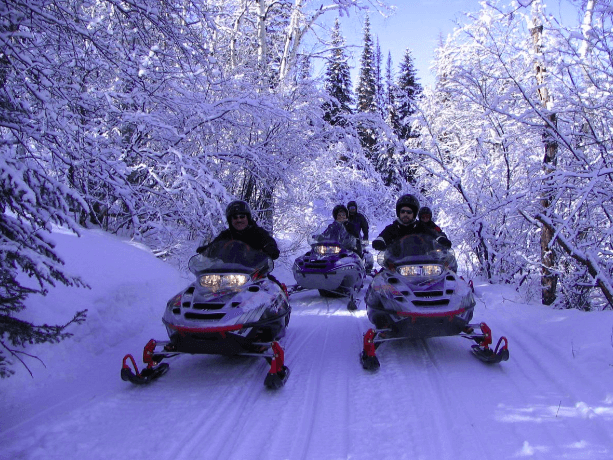
Alberta snowmobiling provides an exciting winter adventure in the middle of the Canadian Rockies. Here’s a rundown of snowmobiling in Alberta:
Mountain Range:
The spectacular alpine scenery of Alberta provides a striking background for snowmobilers. The Canadian Rockies provide thick snow and a variety of riding experiences, making it a perfect location for riders looking for both hard and spectacular excursions.
Season:
Depending on snow conditions, the snowmobile season in Alberta normally lasts from December to April. Because of the cooler temperatures, high-altitude places such as Kananaskis and Crowsnest Pass sometimes experience longer seasons.
Varied Trails:
The snowmobile tracks in Alberta range from groomed roads for novices to more difficult wilderness routes for expert riders. The varied geography of the province includes alpine meadows, deep woods, and frozen lakes.
Trail Services:
Warming huts, trailside lodges, and fuel stations may be found along Alberta’s snowmobile tracks, making it easy for riders to organise prolonged journeys and explore the rugged terrain.
Safety:
Snowmobilers in Alberta prioritise safety above anything else. When riding in hilly terrain, riders are recommended to observe safety standards, carry suitable gear and check avalanche conditions.
Local Clubs:
Alberta has a number of snowmobile organisations and groups that aim to maintain and promote the trail system, providing riders with route maps, updates, and useful information.
Alberta’s snowmobile landscape is distinguished by breathtaking mountain panoramas, deep powder, and the ability to enjoy both hard and enjoyable excursions. Whether you’re a seasoned rider or just starting out, Alberta’s snowmobile locations provide an amazing winter experience in the heart of the Rockies. This is one of the Best places to snowmobile in Canada.
4- Ontario snowmobiling
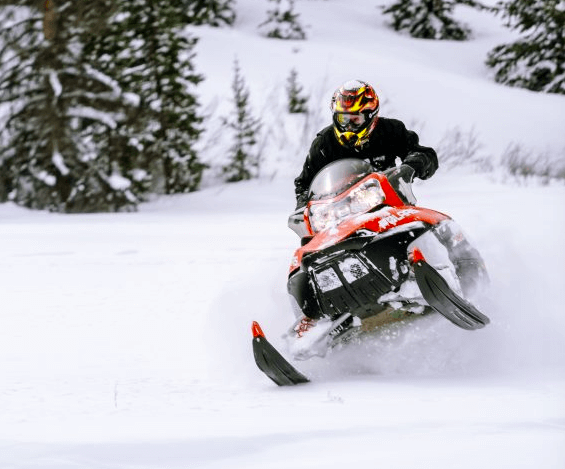
Ontario is a terrific location for snowmobilers, with a vast network of well-maintained snowmobile tracks and different landscapes to explore. Here’s a rundown of snowmobiling in Ontario:
Trail System:
With thousands of km of interconnecting tracks, Ontario has one of the most comprehensive snowmobile trail networks in North America. These pathways pass through beautiful scenery such as woods, lakes, and attractive little villages.
Variety of scenery:
Snowmobilers in Ontario may enjoy a variety of landscapes, including rolling hills and flat farms, as well as deep woods and frozen lakes. Because of this variety, Ontario is excellent for cyclists of all ability levels.
Season:
In Ontario, the snowmobile season normally lasts from December to March or April, depending on the location and weather conditions. Because of the cooler weather, certain locations in Northern Ontario may enjoy an extended season.
Trail Services:
Along its snowmobile tracks, Ontario provides a variety of facilities such as warming shelters, fuel stops, and lodging. These features make multi-day travels more convenient for motorcyclists.
Safety:
In Ontario’s snowmobile community, safety is a top issue. Before venturing out, riders are advised to observe safety instructions, wear suitable gear, and verify trail conditions.
Local Associations:
There are various snowmobile organisations and groups in Ontario that assist to maintain and promote the trail system. These organisations frequently give maps, trail updates, and other useful information to cyclists.
The snowmobile season in Ontario is distinguished by spectacular winter landscape and a strong sense of camaraderie among riders. Ontario is an ideal location for both experienced snowmobilers and those eager to experience the thrill of this winter activity, thanks to its wide route network and various landscapes.
5- British Columbia snowmobiling
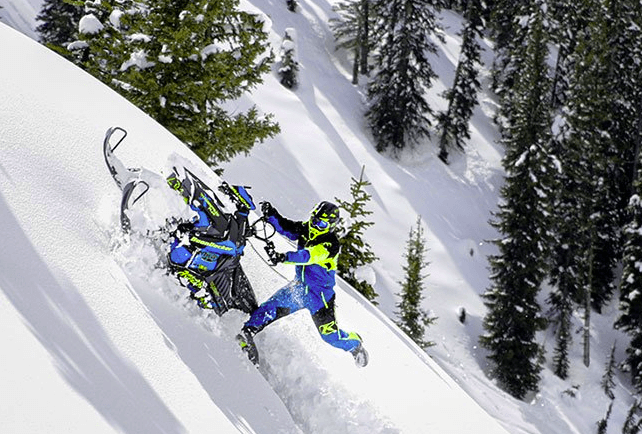
Snowmobiling in British Columbia is an unforgettable experience in the heart of the Canadian Rockies. This province is well-known for its spectacular alpine scenery, dense powder snow, and numerous snowmobiling chances. The Revelstoke region, in particular, stands out as a prominent snowmobiling destination, with access to tough tracks, wide alpine meadows, and breathtaking panoramas. Riders may explore a variety of terrain, including steep slopes and broad fields, making it perfect for beginner and experienced snowmobilers.
The snowmobile season in British Columbia normally lasts from December to April, and the region is recognised for its constant snowfall. Riders should follow safety standards and constantly check local trail conditions and laws while enjoying this winter beauty. British Columbia is a great choice for anyone looking for an amazing snowmobile experience, thanks to its stunning landscape and exhilarating terrain.
6- Quebec Snowmobiling
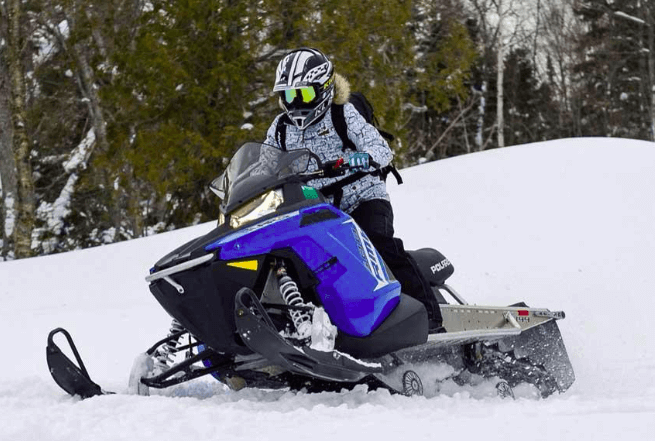
With its wide and well-maintained route network, Quebec provides one of the best snowmobiling experiences in Canada. The province has approximately 33,000 km of interconnecting snowmobile routes, giving riders access to a variety of breathtaking settings, ranging from lovely communities to deep wilderness. The snowmobile season in Quebec normally lasts from December to March, and riders may visit places such as Lanaudière and Mauricie, which are noted for their magnificent tracks and picturesque landscape.
Quebec is a favourite destination for snowmobilers looking for a spectacular winter adventure, thanks to its well-marked tracks, welcoming and diversified terrain. Riders may enjoy both groomed trails and more difficult wilderness sections, making it appropriate for riders of all ability levels. Before beginning on any adventure, it is critical to examine local legislation, trail conditions, and safety requirements.
7- Saskatchewan snowmobiling
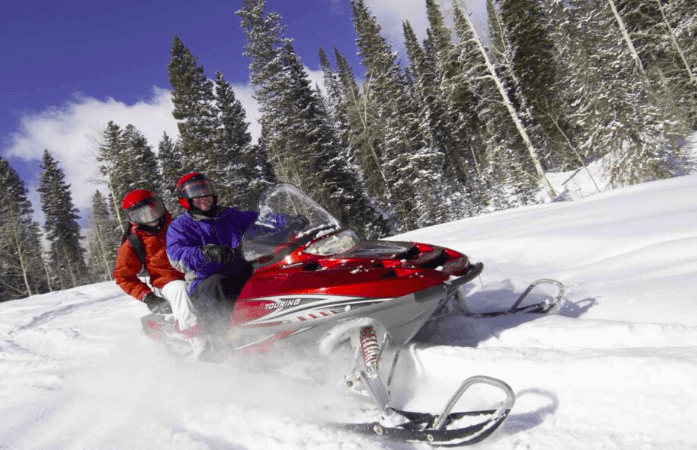
Known for its plains and huge vistas, Saskatchewan also provides a unique and exhilarating snowmobile experience throughout the winter months. Here’s a quick rundown of Saskatchewan snowmobiling:
Varied Terrain:
Snowmobiling paths in Saskatchewan transport riders through a variety of environments, including broad plains, rolling hills, and wooded areas. Because of its versatility, it is appropriate for riders of all ability levels, from beginners to seasoned aficionados.
System of Trails:
Saskatchewan boasts a network of well-kept snowmobile routes that are groomed on a regular basis, giving riders with dependable and pleasurable rides. These routes frequently travel through scenic locations and link to other destinations.
Seasonal Length:
Depending on the weather, the snowmobile season in Saskatchewan normally lasts from December to March. Because of its position, the province regularly receives persistent snowfall during the winter.
Safety:
In Saskatchewan’s snowmobile community, safety is a top issue. Riders are asked to adhere to safety requirements, carry suitable gear, and remain up to date on trail conditions and local legislation.
Local Clubs:
Snowmobile clubs and groups in Saskatchewan aim to preserve and promote the trail system. These organisations offer useful information, trail updates, and frequently arrange events and meetings for the snowmobile community.
Services and amenities include:
Riders may find facilities such as warming huts, fuel stops, and lodging along Saskatchewan’s snowmobile tracks, making it easy for those planning lengthy journeys.
Snowmobiling in Saskatchewan allows you to explore the province’s winter splendour, enjoy well-maintained paths, and experience the distinctive snow-covered prairie vistas.
While admiring Canada’s winter splendour, it’s critical to prioritise safety, follow local legislation, and be cognizant of environmental conservation initiatives. A snowmobile trip in Canada promises wonderful experiences and the opportunity to immerse yourself in the unique splendour of this vast and snow-covered country with proper planning and a sense of adventure. So, whether you’re cutting trails through stunning mountain scenery or gliding across frozen lakes, Canada’s snowmobile sites will leave an everlasting imprint on your winter travels.
FAQs About Snowmobiling in Canada
can you snowmobile in yellowstone?
Snowmobiling is permitted in Yellowstone National Park, but only under strict conditions designed to conserve the park’s natural and cultural values. Here are some essential facts concerning snowmobiling in Yellowstone:
Winter Season:
Snowmobiling is only permitted in Yellowstone during the winter season, which runs from mid-December to mid-March. The precise dates are subject to change based on weather and park management choices.
Tours with a Guide:
The majority of snowmobile access to the park is provided by guided trips. These trips are led by licenced commercial tour companies that follow park laws. Visitors are not permitted to snowmobile on their own in the park.
Permit Requirements:
To ride a snowmobile into Yellowstone, you must first get a permission from one of the authorised tour providers.
When is the Canadian snowmobile season?
In Canada, the snowmobile season normally begins in late autumn, around November or December, and can persist until early spring, sometimes until March or April. The precise timing, however, might vary based on the locality and local meteorological circumstances.
Is a licence required to drive a snowmobile in Canada?
To use a snowmobile in Canada, you must have a valid snowmobile licence or permit. Specific standards and restrictions may differ by province or territory, so check with local authorities.
Is there an age limit for snowmobiling in Canada?
The minimum age for snowmobiling varies by province and territory. There are sometimes age limitations for operating a snowmobile, and younger riders may be required to undergo safety training courses or ride under the supervision of an adult.
What safety equipment is needed for snowmobiling in Canada?
A helmet, suitable cold-weather clothing, gloves, and insulated boots are all required safety equipment while snowmobiling in Canada. To be warm in chilly weather, it’s critical to wear in layers. Avalanche safety equipment is also recommended in many regions for backcountry bikers.
Where can I find snowmobile trails and maps in Canada?
Snowmobile paths and maps are often available via local snowmobile clubs, provincial or territorial governments, or tourist information centres. There are other online tools and smartphone apps to assist you plan your journeys.
Is renting snowmobiles possible in Canada?
Snowmobile rentals are available at numerous Canadian snowmobiling spots. You can look for suitable rental choices at nearby rental shops or resorts.
What are some snowmobile safety recommendations in Canada?
When snowmobiling, safety is of the utmost importance. Always check the weather and trail conditions, ride with a friend, notify someone of your plans, carry necessary safety equipment, and follow local rules and speed restrictions.
Is it possible to go backcountry snowmobiling in Canada?
Yes, there are various backcountry snowmobile chances in Canada, notably in British Columbia, Yukon, and sections of Alberta. When heading into the wilderness, it is critical to have the proper equipment and information.
Is it legal for me to bring my own snowmobile to Canada for a snowmobiling trip?
You may transport your snowmobile to Canada for a snowmobiling adventure, but you must follow Canadian customs and immigration restrictions. Check that your snowmobile complies with Canadian safety and environmental regulations.
What are some of Canada’s most popular snowmobile destinations?
Quebec, British Columbia, Ontario, Alberta, Newfoundland and Labrador, and Yukon are popular snowmobile locations in Canada, each with its own set of experiences and terrain.






